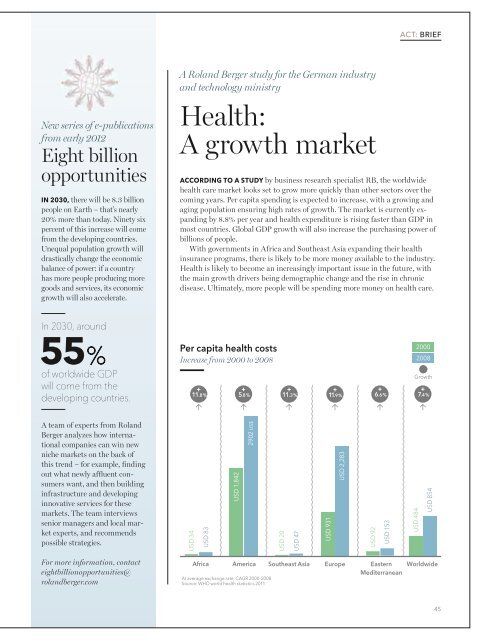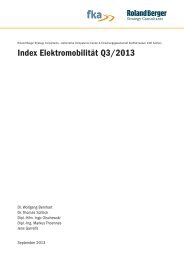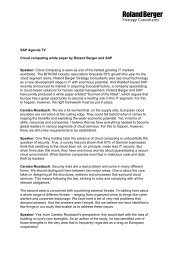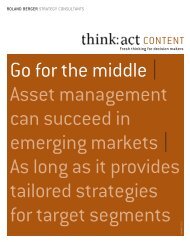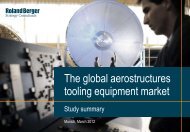think: act magazine No. 17 - Size Matters - Roland Berger
think: act magazine No. 17 - Size Matters - Roland Berger
think: act magazine No. 17 - Size Matters - Roland Berger
Create successful ePaper yourself
Turn your PDF publications into a flip-book with our unique Google optimized e-Paper software.
<strong>act</strong>: bRiefNew series of e-publicationsfrom early 2012Eight billionopportunitiesIN 2030, there will be 8.3 billionpeople on Earth – that’s nearly20% more than today. Ninety sixpercent of this increase will comefrom the developing countries.Unequal population growth willdrastically change the economicbalance of power: if a countryhas more people producing moregoods and services, its economicgrowth will also accelerate.A <strong>Roland</strong> <strong>Berger</strong> study for the german industryand technology ministryHealth:A growth marketaCCOrDING tO a stUDY by business research specialist RB, the worldwidehealth care market looks set to grow more quickly than other sectors over thecoming years. Per capita spending is expected to increase, with a growing andaging population ensuring high rates of growth. The market is currently expandingby 8.8% per year and health expenditure is rising faster than GDP inmost countries. Global GDP growth will also increase the purchasing power ofbillions of people.With governments in Africa and Southeast Asia expanding their healthinsurance programs, there is likely to be more money available to the industry.Health is likely to become an increasingly important issue in the future, withthe main growth drivers being demographic change and the rise in chronicdisease. Ultimately, more people will be spending more money on health care.In 2030, around55%of worldwide GDPwill come from thedeveloping countries.Per capita health costsIncrease from 2000 to 200820002008Growth11.8 % 5.8 %11.3 % 11.9 % 6.6 %7.4 %A team of experts from <strong>Roland</strong><strong>Berger</strong> analyzes how internationalcompanies can win newniche markets on the back ofthis trend – for example, findingout what newly affluent consumerswant, and then buildinginfrastructure and developinginnovative services for thesemarkets. The team interviewssenior managers and local marketexperts, and recommendspossible strategies.UsD 34UsD 83UsD 1,8422902 Us$UsD 20UsD 47UsD 931UsD 2,283UsD 92UsD 153UsD 484UsD 854For more information, cont<strong>act</strong>eightbillionopportunities@rolandberger.comafrica america Southeast asia EuropeAt average exchange rate, cAGr 2000-2008source: WHo world health statistics 2011Easternmediterraneanworldwide45


